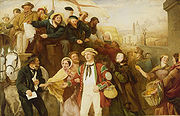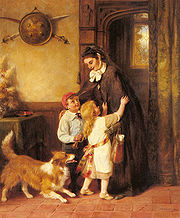
George Bernard O'Neill
Encyclopedia

Cranbrook Colony
The Cranbrook Colony was a group of artists who settled in Cranbrook, Kent from 1854 onwards and were inspired by seventeenth century Dutch and Flemish painters...
of artists.
Life and work

Ireland
Ireland is an island to the northwest of continental Europe. It is the third-largest island in Europe and the twentieth-largest island on Earth...
, the ninth of fifteen children of a Dublin Ordnance clerk. He arrived in England in 1837, went to school in Woolwich
Woolwich
Woolwich is a district in south London, England, located in the London Borough of Greenwich. The area is identified in the London Plan as one of 35 major centres in Greater London.Woolwich formed part of Kent until 1889 when the County of London was created...
and was accepted at the Royal Academy
Royal Academy
The Royal Academy of Arts is an art institution based in Burlington House on Piccadilly, London. The Royal Academy of Arts has a unique position in being an independent, privately funded institution led by eminent artists and architects whose purpose is to promote the creation, enjoyment and...
Schools in 1845. He was a successful student, regularly exhibited at the Royal Academy from 1847 onwards, and gained a reputation as a painter of charming narrative scenes. 'The Foundling', exhibited in 1852, demonstrated his awareness of works by Old Masters combined with the appealing subject of an orphaned child.
In 1855 O'Neill married Emma Stuart Callcott, a cousin of John Callcott Horsley
John Callcott Horsley
John Callcott Horsley RA , was an English Academic painter of genre and historical scenes, illustrator, and designer of the first Christmas card. He was a member of the artist's colony in Cranbrook.-Life:...
. Through this marriage he entered Horsley’s artistic circle and by 1859 was introduced to the Cranbrook Colony
Cranbrook Colony
The Cranbrook Colony was a group of artists who settled in Cranbrook, Kent from 1854 onwards and were inspired by seventeenth century Dutch and Flemish painters...
. Next year George and Emma leased a medieval timber-framed, 'Old Wilsley House', about one mile away from the town of Cranbrook
Cranbrook
-People:* Earl of Cranbrook, title in the Peerage of the United Kingdom** Gathorne Gathorne-Hardy, 1st Earl of Cranbrook , British Conservative politician** John Stewart Gathorne-Hardy, 2nd Earl of Cranbrook , Conservative Member of Parliament...
and maintained it as a summer home and studio for many years. It became a setting for many of O'Neill's paintings.
O' Neill's artistic manner was similar to that of Thomas Webster
Thomas Webster (painter)
Thomas Webster , was an English genre painter, who lived for many years at the artists' colony in Cranbrook.-Life:Webster was born in Ranelagh Street, Pimlico, London...
and Frederick Daniel Hardy
Frederick Daniel Hardy
Frederick Daniel Hardy was an English genre painter and member of the Cranbrook Colony.-Life:Hardy was born in Windsor in Berkshire, one of six children of George Hardy , a musician to George IV, Queen Adelaide and Queen Victoria in the Royal household at Windsor...
. The close relationship between O'Neill and Hardy can be judged from their little painting 'The Surprise' where Hardy painted the interior and O'Neill - the figure (Wolverhampton Art Gallery).
Scenes of rural life - virtuous, innocent, sometimes slightly comical, sometimes sentimental, painted on small domestic scale, appealed to middle-class customers. The height of his success was in the 1850s-1870s, when his works were eagerly collected by Midlands industrialists and the entrepreneurs of other industrial regions of the country. This feeling of public success was expressed in O'Neill's painting 'Public Opinion', which had been shown at the Royal Academy in 1863 (at present at the Leeds City Art Gallery).
O’Neill also kept a home and studio in London
London
London is the capital city of :England and the :United Kingdom, the largest metropolitan area in the United Kingdom, and the largest urban zone in the European Union by most measures. Located on the River Thames, London has been a major settlement for two millennia, its history going back to its...
, where he spent the winter months participating in the capital's artistic life. In the 1870s, along with George Henry Boughton
George Henry Boughton
George Henry Boughton was an Anglo-American landscape and genre painter, illustrator and writer.-Life and work:...
, he became friends with James McNeill Whistler
James McNeill Whistler
James Abbott McNeill Whistler was an American-born, British-based artist. Averse to sentimentality and moral allusion in painting, he was a leading proponent of the credo "art for art's sake". His famous signature for his paintings was in the shape of a stylized butterfly possessing a long stinger...
and offered him moral support during the years 1877-78, when Whistler sued the critic John Ruskin
John Ruskin
John Ruskin was the leading English art critic of the Victorian era, also an art patron, draughtsman, watercolourist, a prominent social thinker and philanthropist. He wrote on subjects ranging from geology to architecture, myth to ornithology, literature to education, and botany to political...
for libel. Although O’Neill’s artistic views were in many ways contrary to these of Whistler, they both believed that the artist’s aesthetic purpose gave validity to a work of art.
Most of O’Neill’s paintings associated with the Cranbrook Colony look like sentimental depictions of children and rustic families, but they might have been intended for more serious purpose. It was noticed that
"children can be used to publicize the iniquities of the social system without seeming to attack the social structure; reform might well be achieved by appeals to the conscience through sentiment rather than by reasoned argument and criticism of an overly political character."
If so, O’Neill’s images of children can be seen in the context of Dickens’ novels as a part of the social movements of that time.
The following decades saw a significant decline in the quality of his works and in their popularity. He died in London on 23 September 1917, just two months into his 89th year, having not exhibited for the last 24 years of his life.
Further reading
- Greg, Andrew. The Cranbrook Colony. Exhibition at Wolverhampton Art Gallery, 1977.
- The Cranbrook Colony. Exhibition at The Vestry Hall, Cranbrook. 1981.
- The Cranbrook Colony. An Exhibition on show at the Weald Gallery, Cranbrook Library. 1994.
- The Cranbrook Colony: Fresh Perspectives. Wolverhampton Art Gallery. ISBN 978-0-947642-28-0
External links
- G B O'Neill online (ArtCyclopedia)
- G B O'Neill biography (Janet Whitmore Ph.D. - Rehs Galleries)
- O'Neill biography and works ("The Weald - people, history and genealogy")
- Paintings by O'Neill (Art Renewal Center Museum)
- Hide and seek (Oil on panel, exhibited 1869 at the Royal AcademyRoyal AcademyThe Royal Academy of Arts is an art institution based in Burlington House on Piccadilly, London. The Royal Academy of Arts has a unique position in being an independent, privately funded institution led by eminent artists and architects whose purpose is to promote the creation, enjoyment and...
)

